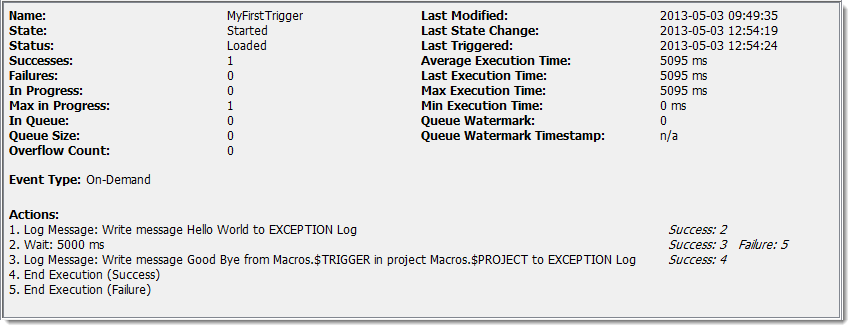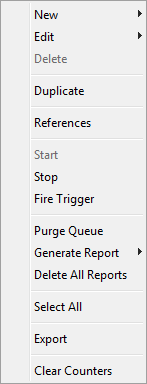In addition to the Projects tab, each individual project will have a tab when the project is opened. When you open a project you will see all the triggers associated to the project. The project tab does not have to be opened to allow triggers to execute.
When a project's tab is displayed in the foreground in the Projects window, you can manage the triggers within the project.
Follow these steps to display a project's tab:
- From the Workbench left hand pane, select and then
expand the node you want to work with.
An expanded tree view of the selected node appears. - Select the Projects icon.
The Projects window appears as the right hand pane with the Projects tab listing all of the defined projects. - Double click the project.
Alternatively, you can select the project and then click the Open button at the bottom of the Projects tab.
The name of the project appears on its tab along with an indication of the project's state, either Started or Stopped.
A project's tab pop-up menu
If you right-click on a individual project tab, a pop-up menu with options is displayed:

The options from this project pop-up menu are:
|
Option |
Description |
|---|---|
|
Start |
Starts the selected project. |
|
Stop |
Stops the selected project. |
|
Export |
Displays the export window, allowing the selection of the items in the project (its triggers) and any of the triggers' dependencies to be exported. |
|
Delete |
Deletes the selected project and all
of the project's triggers. |
A project tab's triggers
When a project's tab is displayed in the foreground, it provides a table displaying its triggers with these columns:
|
Column |
Description |
|---|---|
|
Name |
The name of the trigger. |
|
Type |
The trigger event type, such as Data, Scheduled, On-Demand and so forth. |
|
State |
The trigger's state:
|
|
Status |
The trigger's status:
|
|
Last Triggered |
The date and time the trigger last executed. |
| Last Failure | The date and time the last execution failure of the trigger occurred. |
|
User |
The user that last changed the trigger's state and status. All security requests that must be evaluated by the trigger are based on the access privileges of this user. |
|
Successes |
The number of times the trigger has ended its execution with an end success indication. |
|
Failures |
The number of times the trigger has ended its execution with an end failure indication. |
|
In Progress |
The number of instances of the trigger that are currently executing. The Max in Progress parameter in the trigger definition defines the maximum number of concurrent trigger executions allowed for this trigger. If more than this number are scheduled to execute concurrently, the trigger instances will be queued for later execution based on the Queue Size parameter. |
|
In Queue |
The number of trigger executions that are queued waiting to be executed. |
|
Overflow |
The number of triggers execution instances that could not be executed because the number of trigger execution instances that are in the In Queue reaches the Queue Size parameter in the trigger definition. An increase in a trigger's Overflow counter may mean that the Max in Progress and Queue Size parameters need to be adjusted based on the trigger's event frequency and the trigger's execution time. |
|
Avg Time |
The average execution time of the trigger for the last 10 executions. This value is in milliseconds. |
Summary of trigger characteristics and status
When a trigger is from the table of trigger, a summary
of the trigger's characteristics and status is displayed on
the bottom half of the project's tab. You can see at a
glance the characteristics of the trigger and its execution
statistics:
The additional fields beyond what is displayed in the table of triggers include:
|
Name |
Description |
|---|---|
|
Max in Progress |
The Max in progress parameter from the trigger definition. |
|
Queue Size |
The Queue Size parameter from the trigger definition. |
|
Event Details |
One or more characteristics of the trigger event type. For example: a data event type trigger will display the device variable, a scheduled event type trigger will display the frequency. |
|
Last Modified |
The date and time the trigger last modified. |
|
Last State Change |
The date and time the trigger last changed its state. |
|
Last Execution Time |
The last instance execution time in milliseconds. |
|
Max Execution Time |
The maximum instance execution time in milliseconds. |
|
Min Execution Time |
The minimum instance execution time in milliseconds. |
|
Queue Watermark |
The maximum value that the In Queue parameter contained. |
|
Queue
Watermark
|
The date and time that the Queue Watermark is updated to its maximum value. |
|
Actions |
A summary of the trigger's actions, the actions' parameters and the actions' routes. |
A trigger's pop-up menu
If you right-click on a individual trigger in the
trigger table, a pop-up menu with options is
displayed:
Some menu options will not be available depending on the trigger's state and the event type. The following describes the menu options available from the pop-up menu:
|
Option |
Description |
|---|---|
|
New |
Displays a New Trigger window to define a new trigger. The option includes selecting either the List Editor or the Canvas Editor. |
|
Edit |
Displays a Trigger window to view
and edit the trigger's definition. The
option includes selecting either the
List Editor or the Canvas Editor.
|
|
Delete |
Deletes the trigger. The trigger must be in a Stopped state to allow deleting. |
|
Duplicate |
Duplicates (copies) the trigger definition. The option allows entering a new name for the copy of the trigger and selecting the project for the new trigger. |
|
References |
Displays a list of items that have a reference to the trigger and a list of items that are referenced by the trigger. |
|
Start |
Starts the trigger. The trigger must be in a Stopped state to allowing starting. |
|
Stop |
Stops the trigger. The trigger must be in a Started or Disabled state to allowing stopping. |
|
Fire Trigger |
Executes an On-Demand event type
trigger. |
|
Purge Queue |
Removes all pending trigger execution instances. The number of pending trigger executions is indicated in the trigger's In Queue value. |
|
Generate Report |
Generates a trigger report for the next execution of the trigger. The options are:
You can view the report using the Reports tab. |
|
Delete All Reports |
Deletes all trigger reports generated by the trigger. |
|
Select All |
Selects all of the triggers in the
project. If you want to exclude one or
more triggers from your selection,
after using select all, press and hold
down the Ctrl key, |
|
Export |
Displays the Export window with the selected trigger and allows the trigger and its dependencies to be selected for export to a file on the Workbench's computer. For more information on the Export function, see Exporting a project or trigger. |
|
Clear Counters |
Clears the execution counters from the trigger table. |
Trigger table and option considerations
- A trigger's state must be Started and the trigger's status must be Loaded in order for the trigger to be executed. If the trigger's status is Unloaded, then the project needs to be Started.
- The triggers Successes and Failures counts are based on the trigger ending its execution with an end success or an end failure indication. The counts are not determined based on a trigger action having a failure.
- When editing and then saving a started trigger, the trigger is reloaded upon save, causing all static variables to be reset to their default value.
- When editing and then saving a started trigger, any trigger execution instances that are currently in progress will be completed before the new trigger definition changes take effect.
- If the trigger is being edited by another person, you will receive a message indicating the trigger is locked but still available for view only access.
- Some of the options can be used when multiple
triggers are selected. You can use Ctrl-A, Select All,
Shift-click, Ctrl-click, or press and hold the mouse
button while swiping multiple rows to select multiple
triggers. Then right-click to display the pop-up menu
and selecting an option will attempt to apply the
option to the multiple selected items. If the option
can not be applied, a message window will indicate the
selections that will be applied.
For example, select three stopped triggers and then select Start.
 Started - The
trigger is ready to execute. In
order for a trigger to execute, its
status must also be
Loaded.
Started - The
trigger is ready to execute. In
order for a trigger to execute, its
status must also be
Loaded. Stopped - The
trigger is not ready to execute,
its status is
Unloaded.
Stopped - The
trigger is not ready to execute,
its status is
Unloaded. Disabled - The
trigger is disabled by a fatal
error when processing an event or
action during execution. The system
will periodically attempt to start
triggers that are
Disabled.
Disabled - The
trigger is disabled by a fatal
error when processing an event or
action during execution. The system
will periodically attempt to start
triggers that are
Disabled.